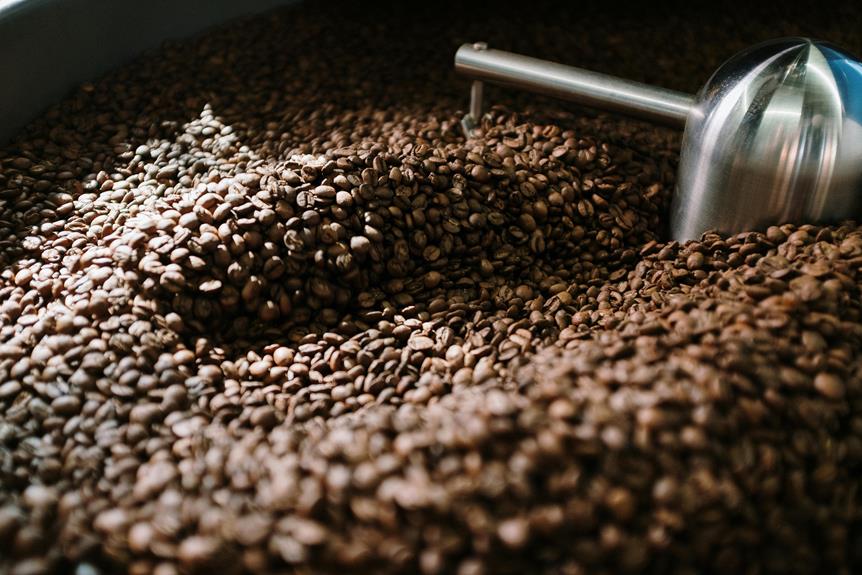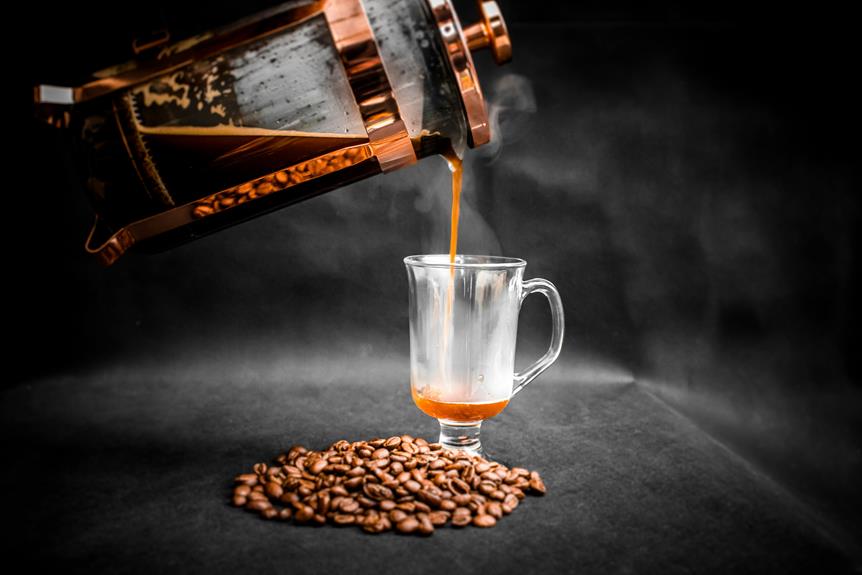You're about to uncover the intricacies of siphon coffee brewing, a method that masterfully combines vacuum dynamics, thermal conduction, and fluid dynamics to extract the perfect cup of coffee. This brewing process involves a delicate balance of elements, where slight adjustments greatly impact the final product. You'll discover how siphon coffee makers work, where heating water creates a pressure difference, allowing water to rise and mix with coffee grounds. As you explore this fascinating method, you'll learn the art of mastering temperature, timing, and technique to harness its full potential – and reveal the secrets to a smoother, full-bodied flavor that will elevate your coffee experience.
Key Takeaways
- Siphon coffee brewing combines vacuum dynamics, thermal conduction, and fluid dynamics to extract a perfect cup of coffee with a smooth, full-bodied flavor.
- The brewing process involves heating water in a lower chamber, which rises into an upper chamber holding coffee grounds, and then flows back into the lower chamber after steeping.
- Mastering temperature, timing, and technique is crucial for harnessing the full potential of siphon coffee making, requiring finesse, attention to detail, and a nuanced expression of creativity.
- Siphon coffee brewing offers benefits including an exceptionally smooth flavor, unique sensory appeal, and a ritualistic experience that elevates the coffee experience.
- To perfect the siphon, use fresh, high-quality coffee beans, experiment with brewing times, monitor temperature, and pay attention to the bloom to achieve ideal extraction.
The Science Behind Siphon Brewing
As you venture into the world of siphon brewing, you'll discover that the process relies on a combination of vacuum, temperature, and fluid dynamics to extract the perfect cup of coffee.
At its core, siphon brewing is a delicate balance of these elements, which work together to produce a smooth and full-bodied flavor.
Vacuum dynamics play a vital role in this process, as the partial vacuum created in the brewing chamber allows the coffee grounds to steep evenly and extract the desired flavors.
Meanwhile, thermal conduction helps to maintain a consistent temperature throughout the brewing process, ensuring that the coffee doesn't become too hot or too cold.
As you experiment with siphon brewing, you'll find that even slight adjustments to these variables can greatly impact the final product.
How Siphon Coffee Makers Work
Siphon coffee makers, also known as vacuum brewers, consist of two main chambers: an upper chamber for holding the coffee grounds and a lower chamber for collecting the brewed coffee.
The upper chamber is typically made of heat-resistant glass or stainless steel, allowing for ideal material selection to withstand the brewing process. The lower chamber is usually made of the same material, ensuring a seamless shift of flavors.
When you heat the water in the lower chamber, it creates a pressure difference between the two chambers. This pressure difference is the core of vacuum dynamics, allowing the water to rise into the upper chamber, where it mixes with the coffee grounds.
As the mixture steeps, the heat is removed, and the pressure difference reverses, causing the brewed coffee to flow back into the lower chamber, leaving the coffee grounds behind.
This process creates a smooth, full-bodied coffee that's free from sediment and bitterness. By understanding how siphon coffee makers work, you'll be able to appreciate the science behind this unique brewing method.
The Art of Siphon Coffee Making
Master the nuances of temperature, timing, and technique to harness the full potential of siphon coffee making, a process that requires finesse and attention to detail.
As you venture into this brewing journey, you'll find yourself immersed in a rich coffee culture that values precision and craftsmanship. With each brew, you'll refine your skills, developing a deeper understanding of the intricate dance between water, coffee, and heat.
Imagine yourself in a tranquil coffee haven, surrounded by:
Gently simmering water, as it rises through the siphon tube, filling the air with anticipation.
Aromatic coffee grounds, carefully measured and poured into the filter, releasing their flavors and oils.
Delicate glassware, showcasing the brew's crystal-clear beauty, as the coffee flows from the siphon into the serving chamber.
Soothing sounds, of the siphon's gentle gurgle, as the coffee flows, filling the air with an sensory experience.
As you master the art of siphon coffee making, you'll discover a world of brewing techniques, each one a nuanced expression of your creativity and passion for coffee.
Benefits of Siphon Coffee Brewing
Siphon coffee brewing offers a multitude of benefits that elevate your coffee experience, from its exceptionally smooth flavor to its unique sensory appeal.
When you brew with a siphon, you'll notice a more nuanced flavor profile, with subtle notes and a cleaner finish. This is because the siphon's vacuum brewing process extracts coffee oils and flavors more evenly, resulting in a balanced cup.
As you watch the coffee brew, you'll appreciate the mesmerizing dance of the liquid and the satisfying gurgle of the siphon. This ritualistic experience becomes an integral part of your daily coffee ritual, making the process just as enjoyable as the final product.
You'll also find that siphon coffee is less bitter and acidic, with a smoother mouthfeel that's easier on the palate.
Tips for Perfecting the Siphon
To get the most out of your siphon coffee brewing experience, it's worth fine-tuning your technique to guarantee a perfect cup every time.
As you experiment with different roasts and brewing times, keep track of your progress in a Coffee Diary or Brewing Journal. This will help you identify patterns and make adjustments to perfect your craft.
Use fresh, high-quality coffee beans: Freshly roasted and ground beans will result in a more flavorful cup.
Experiment with brewing times: Find the sweet spot that brings out the ideal flavor and aroma for your preferred roast.
Monitor the temperature: Aim for a temperature between 195°F and 205°F for perfect extraction.
Pay attention to the bloom: Allow the coffee to bloom for 30-45 seconds to facilitate even extraction.
Frequently Asked Questions
Can I Use Siphon Coffee Makers for Tea or Other Beverages?
You can definitely experiment with siphon coffee makers for tea or other beverages, adjusting steep times and infusion methods to suit your taste, since the device's vacuum principle allows for versatile brewing possibilities.
Are Siphon Coffee Makers Dishwasher Safe?
You're likely one of the 70% of coffee lovers who prioritize convenience! When it comes to siphon coffee makers, you'll be relieved to know that most are dishwasher safe, thanks to their high-quality, BPA-free materials that guarantee easy cleaning and durability.
Can I Use Pre-Ground Coffee With a Siphon Coffee Maker?
You can use pre-ground coffee with a siphon maker, but you'll compromise on flavor and aroma. For superior coffee quality, you're better off with a fresh grind, which allows you to customize the coarseness to your liking.
How Often Should I Clean My Siphon Coffee Maker?
Just as a clean slate refreshes your mind, a clean siphon coffee maker revives your brew. You should clean it every 3-5 brews to maintain Coffee Hygiene, depending on your Brew Frequency, to prevent buildup and bitter flavors.
Can I Make Cold Brew With a Siphon Coffee Maker?
You can experiment with cold brew nuances using your siphon coffee maker, but you'll struggle to replicate the exact flavor profiles of traditional cold brew due to the siphon's heat-based brewing process.
Conclusion
You've made it to the end of this siphon coffee journey, and you're probably thinking, 'Wow, this is a lot of work just for a cup of coffee.' And you're right, it is.
But then again, isn't that what makes it so satisfying?
The hissing steam, the glowing heat, the delicate dance of water and air – it's all worth it for that perfect, velvety cup.
So go ahead, take a sip, and revel in the absurdity of it all.









